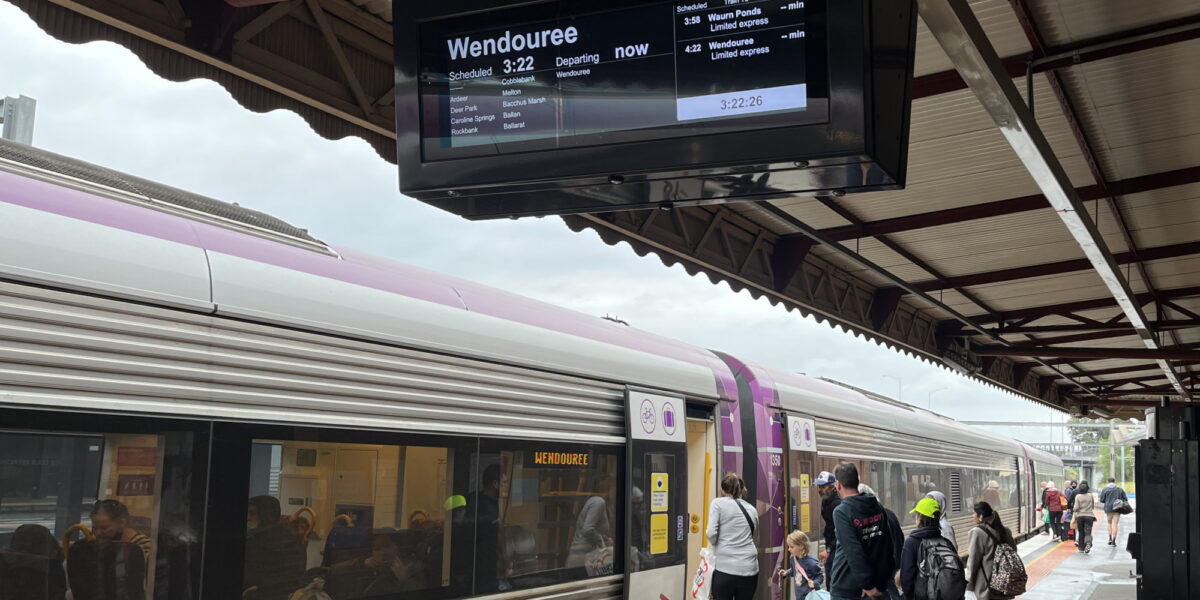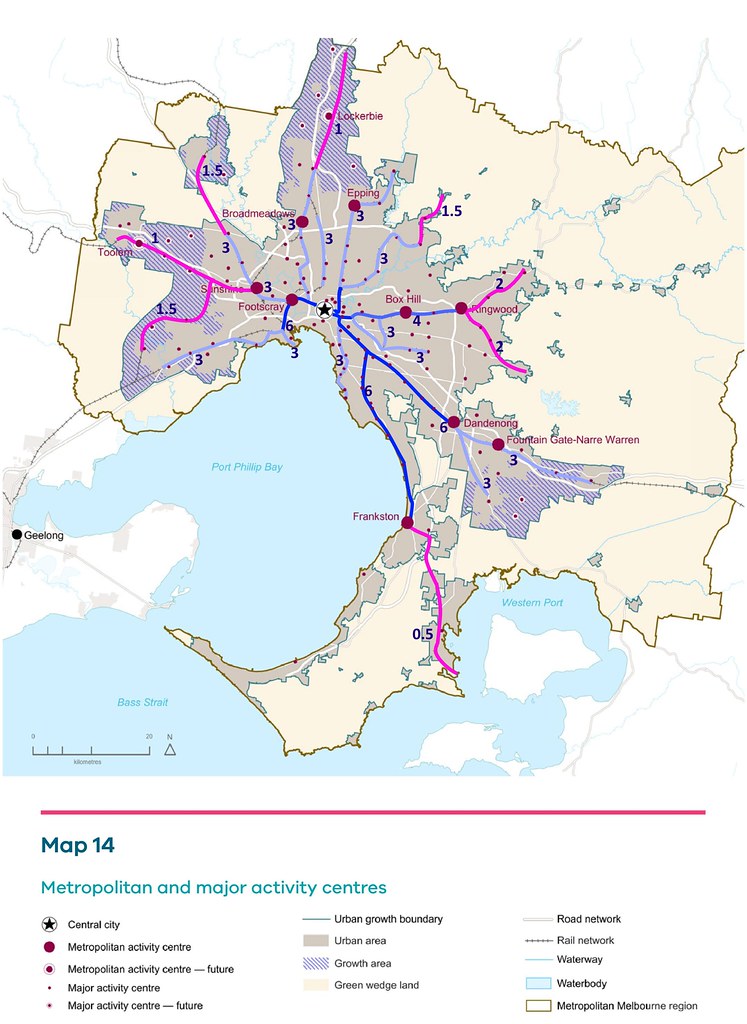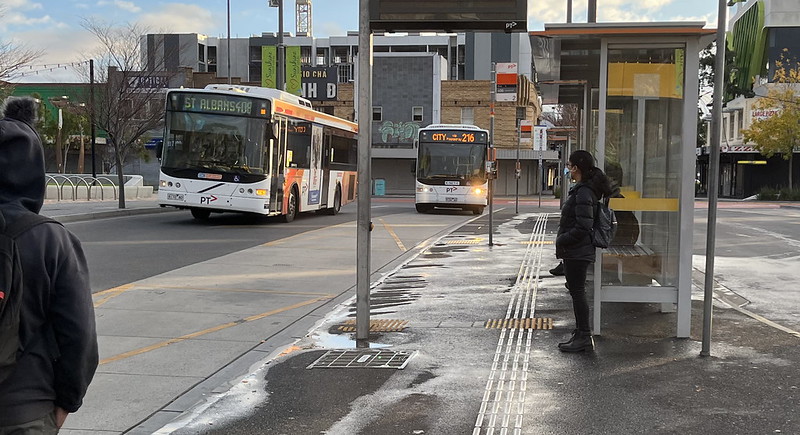A few months ago I did a map summarising daytime/all day service frequency on the rail network. Some discussion on Twitter last week harked back to this, but reminded me that the network does not exist in isolation. A line on a map with stations serves housing and activity centres.
Planning and transport are intertwined. And fortunately, much of Melbourne developed around the rail network, so to this day, most activity centres are near railway stations.
But a railway line a station don’t necessarily mean a high quality service.
To illustrate the varying train frequencies to different parts of Melbourne, including the activity centres and growth areas, I’ve modified the Plan Melbourne map to show the daytime (off-peak) trains per hour.
Base map source: Plan Melbourne – map 14
The numbers and colours represent trains per hour during the day:
- Dark blue: 6+ trains per hour (eg every 10 minutes or better)
- Medium blue: 4+ trains per hour
- Light blue: 3 trains per hour
- Purple: less than 3 trains per hour (eg every 30 minutes or worse)
Important: similar to this map from February, where daytime weekday off-peak and weekend train frequencies differ, I’ve showed the lower of the two. Why? Because overall travel demand is high at all times of the week, not just peak hours, and not just weekdays.
It’s worth noting that a number of inner-suburban activity centres are not on the rail network, but are served by trams – those lines are not shown here.
Growth areas
What’s striking is the poor service to the growth areas served by V/Line in Melbourne’s outer west, and north, including planned activity centres at Toolern and Lockerbie. Weekend frequencies are particularly poor.
You can easily argue that these areas should be switched onto the Metro suburban system. But whether it’s V/Line or Metro operating the trains, a decent service should be provided – at least 3 trains per hour every day.
And more Metro lines should be running 6 trains per hour (every 10 minutes) to cut waiting times, add capacity (including for big events) and make end-to-end journeys (including interchanges) more competitive with cars.
Some lines already have 10 minute all-day services, but existing Metropolitan Activity Centres at Sunshine, Broadmeadows and Epping are missing out here, and Box Hill and Ringwood need work here too.
Buses too
Buses into activity centres should be high quality too. Most of those shown have Smartbus services: Fountain Gate is the odd one out (and it’s a bit of a walk from the station too), and the future big centres at Toolern and Lockerbie will need them.
Existing Smartbuses also need a boost, particularly at weekends where half-hourly services are typical, and most other routes are also substandard if you actually want people to choose to use them.
Activity centres, especially the big Metropolitan Activity Centres, should have frequent public transport in all directions from the surrounding areas.
More trains more often
Focussing back on rail, it’s important to remember that service boosts outside peak hours mostly do not require more infrastructure, and are not expensive compared with the current cost of running the system.
There are promising moves with the recent funding of “more than 100” additional drivers, though at present it’s unclear what the service outcomes will be, and how many lines will benefit.
Higher frequency train and bus services all week are hugely beneficial for better coping with current loads, and getting more people on board more often by making public transport a better alternative to driving.
The state election is 5 months away. How about it, pollies?



3 replies on “Train services to activity centres and growth areas”
You only have to look at a Melbourne tram map to see how neglected the inner west of Melbourne is. I would argue that the Suburban Train Loop should focus more on western suburbs and needs a review. The map at the beginning of this article is very telling. https://www.broadsheet.com.au/melbourne/city-file/article/everything-you-need-know-about-suburban-rail-loop
The frequency of services in Melbourne is my biggest bugbear, can take ages to get from point A to B because of the poor service frequency. Having a bus, tram or train run every 20min when you’re less than 5 km from the centre of a major city centre isn’t a functional transport system, it’s a token gesture.
From the city out to around 10km (Lalor, Macleod, Brighton Beach, Sunshine, Holmesglen, Moorabbin, Gowrie, Broadmeadows, Oakleigh, Box Hill) we could have a genuine off-peak metro service of every 5min.
Beyond that (Frankston, Dandenong, Ringwood, Eltham, Mernda, Upfield, Glen Waverley, Alamein, Sandringham, Sundury, Craigieburn, Watergardens, Werribee) a train every 10 min.
And in low density outer Melbourne (Cranbourne, Hurtsbridge, Pakenham, Belgrave, Lilydale) a 20min frequency.
Running staggered services are how many systems around the world operate, and once upon a time Melbourne did the same, and with the trams too. But decades of public transport cut backs have left us with a feeble dysfunctional system at a time when Melbournes population is heading towards 8 million, plus if we’re going to get serious about environmental issues we need to tackle the service frequency problem to entice people out of cars.
Well giving that East Werribee was supposed to be a jobs precinct and people from Wyndham have mostly Shopping centres to get employment living in west werribee I’m 10 minutes to Wyndham Vale station and 10 minutes to Werribee station but my bus is 40 minutes in day 20 in peak what they need to do is keep there promise and make an employment precinct so people can get jobs closer to home also building more stations and making Wyndham Vale a metro service is what needs to happen